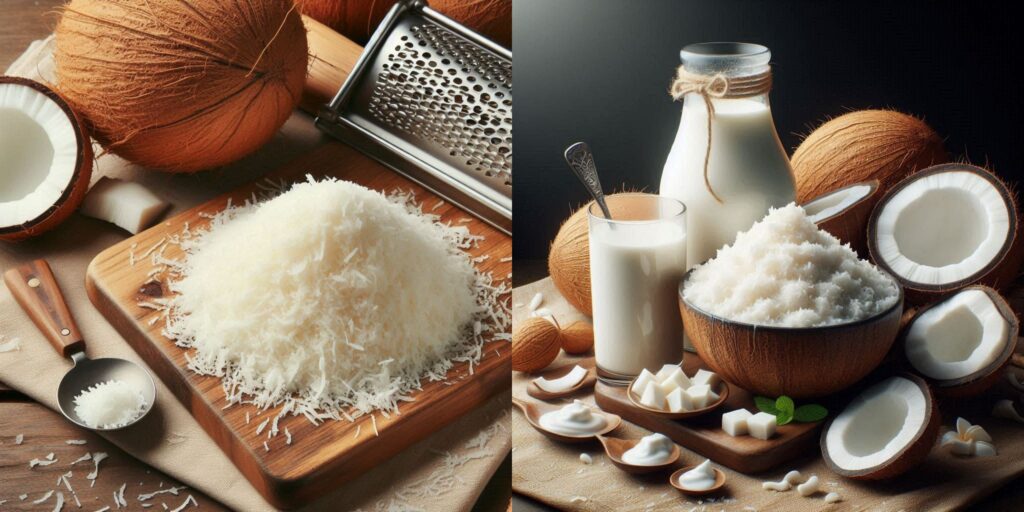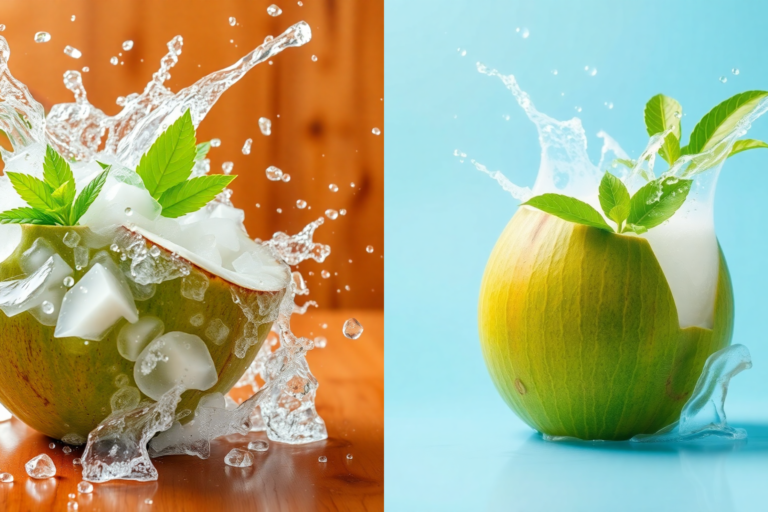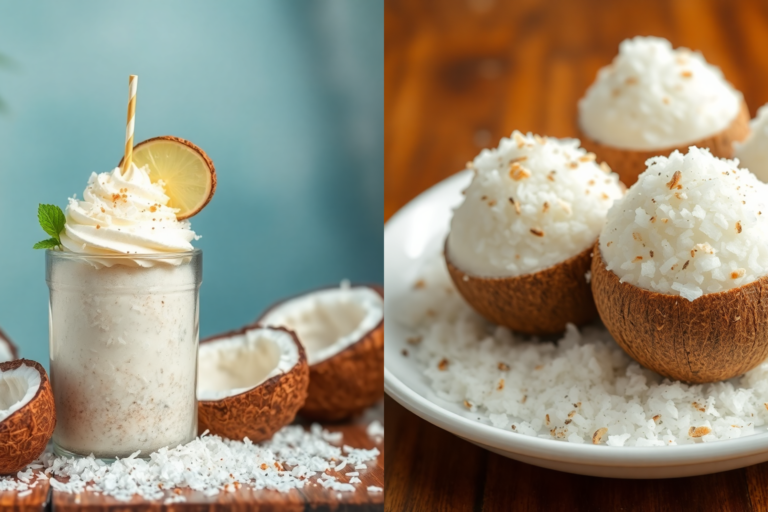Grated Coconut: Exploring Definition and Types
Introduction of Grated Coconut
Definition and Types of Grated Coconut (Fresh vs Dried)
Grated coconut refers to coconut meat that has been finely shredded or grated into small, thin pieces. It is available in two main forms: fresh grated coconut and dried grated coconut. Each type offers distinct flavors and uses in culinary applications.
Overview of Its Culinary Versatility and Nutritional Value
Grated coconut is renowned for its culinary versatility and rich nutritional profile. Whether fresh or dried, it adds a delightful coconut flavor and texture to a wide range of dishes, making it a popular ingredient in various cuisines worldwide.
The Culinary Uses of Grated Coconut
Grated Coconut in Culinary Delights: A Versatile Ingredient
Fresh Grated Coconut
Fresh grated coconut is derived from the flesh of mature coconuts. It is moist, slightly sweet, and has a creamy texture. Commonly used in both savory and sweet dishes, fresh grated coconut enhances curries, salads, desserts, and beverages with its natural richness and aroma.
Dried Grated Coconut
Dried grated coconut, also known as desiccated coconut, is made from the finely grated, dried flesh of mature coconuts. It is available in various textures, from fine to coarse, and can be either sweetened or unsweetened. Dried grated coconut is shelf-stable and widely used in baking, confectionery, granola bars, and as a topping for cakes and pastries.
Nutritional Benefits of Grated Coconut
Grated Coconut: Nutritional Value and Health Benefits
Rich in Dietary Fiber
Both fresh and dried grated coconut are rich in dietary fiber, which aids digestion, promotes satiety, and supports overall gut health.
Healthy Fats and Nutrients
Grated coconut contains healthy fats, including medium-chain triglycerides (MCTs), which are easily metabolized for energy. It is also a good source of essential minerals such as manganese, copper, and selenium, necessary for metabolic functions and antioxidant defense.
Incorporating Grated Coconut into Your Diet
Grated Coconut: Tips for Culinary Delights
In Savory Dishes
Use fresh grated coconut to add texture and flavor to curries, stir-fries, and rice dishes. Its natural sweetness complements spicy and savory flavors.
In Baking and Desserts
Dried grated coconut adds a tropical twist to baked goods such as cookies, muffins, and pies. It can also be toasted for added depth of flavor.
As a Snack or Topping
Sprinkle dried grated coconut over yogurt, oatmeal, or smoothie bowls for a nutritious crunch. It can also be enjoyed as a standalone snack for a quick energy boost.
Grated Coconut: Exploring Its Nutritional Profile
Nutritional Profile of Grated Coconut
Breakdown of Nutritional Content
Grated coconut, whether fresh or dried, offers a unique nutritional profile rich in essential nutrients. Here’s a detailed breakdown of its key components per 100 grams:
- Calories: Fresh grated coconut typically contains about 354 calories, while dried grated coconut can have around 660 calories due to the concentration of nutrients.
- Fats: Both fresh and dried grated coconut are high in healthy fats. Fresh grated coconut contains approximately 33 grams of fat, primarily saturated fats. Dried grated coconut can have up to 64 grams of fat per 100 grams.
- Carbohydrates: Fresh grated coconut contains around 15 grams of carbohydrates, with a significant portion coming from dietary fiber. Dried grated coconut may have approximately 24 grams of carbohydrates.
- Proteins: Grated coconut is not particularly high in protein, with fresh grated coconut containing about 3 grams and dried grated coconut having around 7 grams of protein.
Comparison of Fresh vs Dried Grated Coconut
Fresh Grated Coconut
Fresh grated coconut is obtained by grating the flesh of a mature coconut. It retains its natural moisture and flavor, offering a slightly sweet taste and a soft texture. Here are some nutritional aspects of fresh grated coconut:
- Moisture Content: Contains higher water content compared to dried grated coconut.
- Nutrient Profile: Provides vitamins such as vitamin C, B vitamins (including folate), and minerals like potassium, manganese, and copper.
- Usage: Often used in fresh preparations like salads, chutneys, and desserts for its mild coconut flavor and soft texture.
Dried Grated Coconut
Dried grated coconut is made by drying fresh grated coconut meat. This process removes moisture, concentrating its nutrients and flavors. Here’s what distinguishes dried grated coconut:
- Concentration of Nutrients: Higher calorie and fat content per gram due to the removal of water.
- Shelf Life: Longer shelf life compared to fresh grated coconut.
- Usage: Commonly used in baking, cooking, and as a topping for various dishes due to its crunchy texture and intense coconut flavor.
Benefits of Grated Coconut in Your Diet
Incorporating Grated Coconut for Nutritional Benefits
Rich Source of Dietary Fiber
Both fresh and dried grated coconut are excellent sources of dietary fiber, promoting digestive health and aiding in weight management.
Healthy Fats
Despite being high in saturated fats, grated coconut contains medium-chain triglycerides (MCTs) that can boost energy levels and support heart health.
Vitamins and Minerals
Grated coconut, especially fresh, provides essential vitamins (like vitamin C and B vitamins) and minerals (such as potassium and manganese) crucial for overall health.
Grated Coconut: A Rich Source of Dietary Fiber
Introduction
Understanding Grated Coconut
Grated coconut, a staple in many cuisines, refers to coconut meat that has been finely shredded or grated. It is commonly used in both savory and sweet dishes, providing a unique texture and flavor.
Overview of Its Use and Popularity
Grated coconut finds widespread use in cooking and baking, where its natural sweetness and rich texture enhance various recipes. From curries to desserts, its versatility makes it a favorite ingredient across cultures.
Importance of Dietary Fiber in Daily Diet
Grated Coconut: Enhancing Your Fiber Intake
The Role of Dietary Fiber
Dietary fiber is crucial for maintaining digestive health, promoting regular bowel movements, and supporting overall well-being. It helps prevent constipation, regulates blood sugar levels, and aids in weight management by promoting a feeling of fullness.
Contribution of Grated Coconut to Fiber Intake
Grated coconut is a significant source of dietary fiber, particularly when consumed in its unsweetened, shredded form. A single cup of grated coconut can provide several grams of fiber, depending on the serving size. This fiber content contributes to meeting daily fiber recommendations, which are essential for optimal health.
Health Benefits of Grated Coconut’s Fiber Content
Grated Coconut: Supporting Digestive Wellness
Promoting Digestive Regularity
The fiber in grated coconut supports digestive regularity by adding bulk to stool and facilitating smooth bowel movements. This helps prevent constipation and promotes a healthy gastrointestinal tract.
Stabilizing Blood Sugar Levels
Fiber-rich foods like grated coconut can help regulate blood sugar levels by slowing down the absorption of sugars into the bloodstream. This may reduce the risk of insulin spikes and promote better glycemic control, especially important for individuals with diabetes or insulin resistance.
Supporting Heart Health
A diet high in fiber, including sources like grated coconut, is associated with a lower risk of heart disease. Fiber helps lower cholesterol levels by binding to cholesterol and promoting its excretion, thereby supporting cardiovascular health.
Incorporating Grated Coconut into Your Diet
Grated Coconut: Tips for Adding Fiber-Rich Goodness
In Baking and Cooking
Use grated coconut in baking recipes for cakes, cookies, and muffins to add moisture, texture, and a hint of natural sweetness. It can also be sprinkled over salads, yogurt, or oatmeal for added crunch and fiber.
As a Snack or Topping
Enjoy grated coconut as a standalone snack or mix it with nuts and dried fruits for a homemade trail mix. Sprinkle it over smoothie bowls or ice cream for a tropical twist and extra fiber boost.
In Savory Dishes
Incorporate grated coconut into curries, stews, and stir-fries to impart a rich coconut flavor and enhance the fiber content of your meal. It pairs well with vegetables, seafood, and poultry dishes.
Grated Coconut: Exploring Healthy Fats and Essential Nutrients
Introduction to Grated Coconut
Definition and Uses of Grated Coconut
Grated coconut, also known as shredded or desiccated coconut, refers to the finely grated, dried, and unsweetened meat of a mature coconut. It is commonly used in various cuisines worldwide for its distinct flavor and texture, adding richness to both sweet and savory dishes.
Versatile Culinary Applications
Grated coconut finds its way into an array of recipes, from traditional desserts and curries to baked goods and savory dishes. Its natural sweetness and nutritional benefits make it a popular ingredient in kitchens globally.
The Nutritional Profile of Grated Coconut
Grated Coconut: A Source of Healthy Fats and Essential Nutrients
Presence of Healthy Fats (Medium-Chain Triglycerides)
Grated coconut is rich in healthy fats, particularly medium-chain triglycerides (MCTs). These fats are easily digested and converted into energy, making grated coconut a valuable addition to a balanced diet.
Vitamins and Minerals in Grated Coconut
Grated coconut contains a variety of essential vitamins and minerals:
Vitamins: Grated coconut is notably rich in B-complex vitamins, including riboflavin (B2) and niacin (B3), which are important for energy metabolism and cellular health. It also provides vitamin E, a powerful antioxidant that supports skin health and immune function.
Minerals: Grated coconut is a good source of minerals such as iron, which is essential for oxygen transport in the blood and zinc, which supports immune function and wound healing.
Health Benefits of Grated Coconut Consumption
Grated Coconut: Enhancing Wellness with Nutrient-Rich Goodness
Supports Energy Production
The medium-chain triglycerides (MCTs) in grated coconut are readily utilized by the body for energy, making it an excellent choice for maintaining energy levels throughout the day.
Promotes Skin and Hair Health
Vitamin E in grated coconut helps maintain skin elasticity and hydration, while its antioxidants protect against oxidative damage that can contribute to premature aging. These benefits extend to promoting strong, healthy hair.
Contributes to Nutrient Intake
Including grated coconut in your diet helps ensure you receive essential vitamins and minerals necessary for overall health and well-being. Its nutrient-dense profile makes it a valuable addition to meals and snacks.
Incorporating Grated Coconut into Your Diet
Grated Coconut: Creative Ways to Enjoy its Benefits
In Baking and Desserts
Use grated coconut as a topping for cakes, cookies, and pies, or incorporate it into the batter for added texture and flavor.
In Curries and Savory Dishes
Add grated coconut to curries, stir-fries, and rice dishes for a touch of tropical sweetness and nutritional goodness.
As a Snack or Garnish
Enjoy grated coconut on its own as a snack, or sprinkle it over yogurt, oatmeal, or smoothie bowls for added crunch and flavor.
Exploring Grated Coconut: Culinary Uses and Techniques
Culinary Uses of Grated Coconut Worldwide
Incorporation into Various Cuisines and Dishes
Grated coconut, a versatile ingredient celebrated for its texture and flavor, is integral to culinary traditions across the globe. From tropical regions to international kitchens, it enriches dishes with its nutty sweetness and creamy consistency.
In Southeast Asian cuisines such as Thai, Malaysian, and Indonesian, grated coconut is a staple in both savory and sweet dishes. It’s used fresh or dried, adding depth to curries, soups, and desserts like coconut rice and coconut-based sauces.
In Indian cuisine, grated coconut plays a crucial role, especially in coastal regions where coconut palms flourish. It’s used in coconut chutneys, coconut-based gravies, and as a topping for various sweets like laddoos and barfis.
In Caribbean and Latin American cooking, grated coconut often stars in traditional dishes like coconut bread, rice and peas, and savory stews where its richness complements spicy flavors.
Techniques for Using Grated Coconut in Cooking and Baking
Grated coconut enhances dishes with its distinct texture and aroma, offering culinary creativity in various forms:
Fresh vs. Desiccated Grated Coconut: Fresh grated coconut provides a moist, rich flavor ideal for immediate use in dishes like salads and desserts. Desiccated grated coconut, on the other hand, is dried and grated finely, lending itself well to baking and long-term storage.
Toasting Grated Coconut: Dry-toast grated coconut in a pan until golden brown to intensify its flavor and add a crunchy texture. This technique is commonly used in toppings for cakes, salads, and ice creams.
Incorporating into Curries and Soups: Add grated coconut to curries and soups to thicken sauces and impart a creamy consistency. It balances spicy flavors and adds a hint of sweetness.
Baking with Grated Coconut: Use grated coconut in baked goods such as cakes, cookies, and bread. It adds moisture, flavor, and texture to these treats, making them more indulgent and satisfying.
Health Benefits Unveiled
Definition and Use of Grated Coconut
Grated coconut, also known as shredded coconut, is the finely grated flesh of mature coconuts. It is widely used in culinary applications worldwide, prized for its rich flavor and versatile texture in both sweet and savory dishes.
Versatility in Cooking and Baking
Grated coconut enhances the taste and texture of various recipes, including desserts, curries, salads, and baked goods. Its natural sweetness and nutritional benefits make it a popular choice in traditional and modern cuisines alike.
Grated Coconut and Its Potential Health Benefits
Grated Coconut: A Nutritional Powerhouse
Supports Heart Health and Metabolism
Grated coconut contains medium-chain triglycerides (MCTs), which are fatty acids that can contribute to improved heart health. MCTs are easily metabolized by the body, providing a quick source of energy and potentially aiding in weight management.
Rich in Dietary Fiber
Dietary fiber found in grated coconut promotes satiety and aids digestion. Fiber helps regulate bowel movements, prevent constipation, and support a healthy gut microbiome.
Role in Promoting Satiety and Aiding Digestion
Grated Coconut: Enhancing Digestive Wellness
Promotes Satiety
The fiber content in grated coconut helps you feel full and satisfied after meals, reducing overall calorie intake and supporting weight management goals.
Aids Digestive Health
Grated coconut’s fiber content supports digestive health by promoting regular bowel movements and feeding beneficial gut bacteria. This aids in nutrient absorption and reduces the risk of digestive disorders.
Incorporating Grated Coconut into Your Diet
Enjoying the Health Benefits of Grated Coconut
In Sweet and Savory Dishes
Sprinkle grated coconut over yogurt, oatmeal, or smoothie bowls for added texture and flavor.
As a Cooking Ingredient
Use grated coconut in baking recipes for cakes, cookies, and muffins, or incorporate it into savory dishes like curries and stir-fries for a tropical twist.
As a Snack or Topping
Enjoy grated coconut as a standalone snack or mix it with nuts and dried fruits for a delicious trail mix.
Conclusion
Summary of the Top 5 Nutrition and Culinary Uses of Grated Coconut
Grated coconut, a versatile ingredient derived from mature coconuts, offers a myriad of nutritional benefits and culinary possibilities. Here’s a recap of its top uses and benefits:
Rich in Dietary Fiber: Grated coconut is an excellent source of dietary fiber, promoting digestive health and aiding in weight management.
Nutrient-Dense Profile: It packs essential vitamins, minerals, and healthy fats, contributing to overall well-being.
Versatile in Cooking: Used in both sweet and savory dishes, grated coconut adds texture and flavor to curries, desserts, salads, and baked goods.
Enhances Flavor: Its natural sweetness and nutty taste elevate dishes, offering a tropical twist to recipes.
Supports Health Benefits: From boosting energy levels to promoting heart health and aiding in skin and hair care, grated coconut is a nutritional powerhouse.
Encouragement to Explore and Incorporate Grated Coconut into Diverse Recipes
Grated coconut’s culinary versatility invites experimentation in the kitchen. Whether you’re blending it into smoothies for added creaminess, sprinkling it over oatmeal for texture, or incorporating it into traditional dishes for authentic flavor, there are countless ways to enjoy its benefits.
Unlock the potential of grated coconut in your culinary journey. Explore new recipes, discover its health benefits, and savor the rich flavors it brings to your table. From breakfast to dessert, grated coconut adds a delightful touch of tropical goodness to every dish.
Start incorporating grated coconut today and experience the nutritional and culinary wonders it has to offer. Your taste buds and your health will thank you for it!











